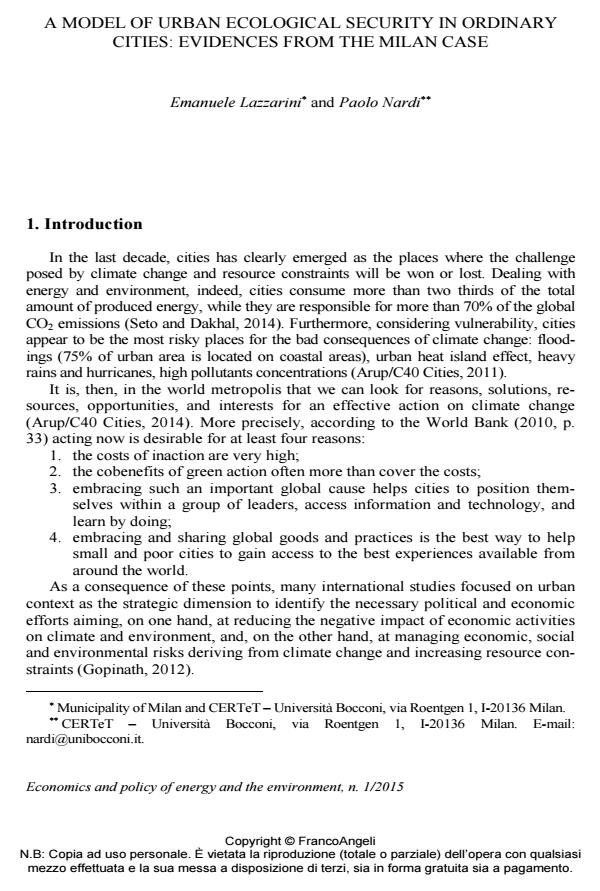A model of urban ecological security in ordinary cities: evidences from the Milan case
Titolo Rivista ECONOMICS AND POLICY OF ENERGY AND THE ENVIRONMENT
Autori/Curatori Emanuele Lazzarini, Paolo Nardi
Anno di pubblicazione 2016 Fascicolo 2015/1 Lingua Inglese
Numero pagine 13 P. 29-41 Dimensione file 177 KB
DOI 10.3280/EFE2015-001003
Il DOI è il codice a barre della proprietà intellettuale: per saperne di più
clicca qui
Qui sotto puoi vedere in anteprima la prima pagina di questo articolo.
Se questo articolo ti interessa, lo puoi acquistare (e scaricare in formato pdf) seguendo le facili indicazioni per acquistare il download credit. Acquista Download Credits per scaricare questo Articolo in formato PDF

FrancoAngeli è membro della Publishers International Linking Association, Inc (PILA)associazione indipendente e non profit per facilitare (attraverso i servizi tecnologici implementati da CrossRef.org) l’accesso degli studiosi ai contenuti digitali nelle pubblicazioni professionali e scientifiche
In the last decade, cities has clearly emerged as the places where the challenge posed by climate change and constraints on energy and environmental resources will be won or lost. According to Hodson and Marvin (2009), world cities tend to conform their visions, strategies and policies around a common paradigm of environmental security and sustainability, named "Secure Urbanism and Resilient Infrastructure" (SURI), based on the strategic protection of cities, a new autarky and the development of global urban agglomerations. What about ordinary cities? This case study on Milan offers a very interesting test field to provide how the SURI model does not fit ordinary cities. Results show that Milan still lacks of a recognized and legitimized subject, capable of coordinating a process of urban visioning and narrative building; at the same time an alternative paradigm emerges, based on bottom-up initiatives.
Keywords:Urban ecological security, climate change, ordinary city
Jel codes:Q20, Q54, R00
- Agenzia per la Mobilità, l’Ambiente e il Territorio (2009). Piano d’azione per l’energia sostenibile e il clima. Milan: AMAT.
- Arup/C40 Cities (2011). Climate Action in Megacities: C40 Cities Baselines and Opportunities. Online at: http://www.arup.com/Home/Publications/Climate_Action_in_Megacities.aspx.
- Arup/C40 Cities (2014). Climate Action in Megacities: C40 Cities Baselines and Opportunities Volume 2.0. Online at: http://issuu.com/c40cities/docs/c40_climate_action_in_megacities.
- Balducci A. (2005). Una visione per la Regione Urbana Milanese. In: Magatti M., Senn L., Sapelli G., Ranci C., Manghi B., Dente B., Colombo A., Ciborra C., Ceruti M., Balducci A. and Artoni R. (Eds.), Milano, nodo della rete globale. Un itinerario di analisi e proposte, pp. 231-264. Milan: Bruno Mondadori.
- Berkhout F., Smith A. and Stirling A. (2003). Socio-technological regimes and transition Contexts. Working Paper No. 106, SPRU, University of Sussex. DOI: 10.4337/9781845423421.00013
- Friedmann J. (1986). The world city hypothesis. Development and Change, 17 (1): 69-83. DOI: 10.1111/j.1467-7660.1986.tb00231.x
- Geels F.W. and Schot J. (2007). Typology of socio-technical transition pathways. Research Policy, 36 (3): 399-417. DOI: 10.1016/j.respol.2007.01.003
- Globalization and World Cities (2012). The World according to GaWC 2012. Online at: http://www.lboro.ac.uk/gawc/world2012t.html.
- Gopinath D. (2012). The future of urban living through the lens of “climate change”? Insights from American initiatives. Environment and Planning A, 44 (2): 257-262. DOI: 10.1068/a44578
- Hall P. (2003). Growing the European Urban System. Working Paper No. 3, Institute of Community Studies, London.
- Hodson M. (2008). Old industrial regions, technology and innovation: tensions of obduracy and transformation. Environment and Planning A, 40 (5): 1057-1075. DOI: 10.1068/a39103
- Hodson M. and Marvin S. (2009). Urban Ecological Security: a New Urban Paradigm? International Journal of Urban and Regional Research, 33 (1): 193-215. DOI: 10.1111/j.1468-2427.2009.00832.x
- Hodson M. and Marvin S. (2010a). Can Cities Shape Socio-Technical Transitions and how Would we Know if they were? Research Policy, 39 (4): 477-485. DOI: 10.1016/j.respol.2010.01.020
- Hodson M. and Marvin S. (2010b). World Cities and Climate Change. Producing Urban Ecological Security. New York: McGraw Hill Open University Press.
- Hopkins R. and Lipman P. (2009). Who we are and what we do. Online at: www.transitionnetwork.org/sites/default/files/WhoWeAreAndWhatWe Do-lowres.pdf.
- Joss S. (2010). Eco-Cities – A Global Survey 2009. Online at: http://www.westminster.ac.uk/__data/assets/pdf_file/0006/57966/Eco-Cities-Survey-2009-Joss.
- LSE Cities (2012). Going Green. How cities are leading the next economy. Roskilde: The 3GF Copenhagen edition.
- Robinson J. (2002). Global and World Cities: A View from off the Map. International Journal of Urban and Regional Research, 26 (3): 531-554. DOI: 10.1111/1468-2427.00397
- Rotmans J., Kemp R. and Van Asselt M. (2001). More Evolution Than Revolution: Transition Management in Public Policy. Foresight, 3 (1): 15-31. DOI: 10.1108/14636680110803003
- Sassen S. (1991). The Global City: New York, London, Tokyo. Princeton, NJ: Princeton University Press.
- Seto K.C. and Dhakal S. (2014). Chapter 12: Human Settlements, Infrastructure, and Spatial Planning. In: IPCC Working Group III – Mitigation of Climate Change. Online at: http://sustainablecities.usc.edu/ipcc_wg3_ar5_final-draft_postplenary_chapter12%281%29.pdf.
- Smith A., Stirling A. and Berkhout F. (2005). The Governance of Sustainable Socio-technical Transitions. Research Policy, 34 (10): 1491-1510. DOI: 10.1016/j.respol.2005.07.005
- Taylor P.J., Derudder B., Saey P. and Witlox F. (Eds.) (2007). Cities in Globalization: Practices, Policies And Theories. London: Routledge.
- The World Bank (2010), Cities and Climate Change: an Urgent Agenda. Washington: The World Bank
- Coupling fuzzy multiple attribute decision-making with analytic hierarchy process to evaluate urban ecological security: A case study of Guangzhou, China P.P. Gao, Y.P. Li, J. Sun, H.W. Li, in Ecological Complexity /2018 pp.23
DOI: 10.1016/j.ecocom.2018.03.001
Emanuele Lazzarini, Paolo Nardi, A model of urban ecological security in ordinary cities: evidences from the Milan case in "ECONOMICS AND POLICY OF ENERGY AND THE ENVIRONMENT" 1/2015, pp 29-41, DOI: 10.3280/EFE2015-001003